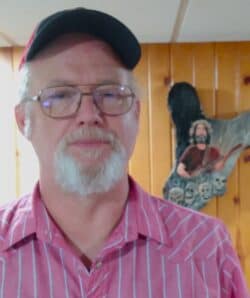August 1, 2022


Rod Peck, Library Technician
At the time of Jerry Garcia’s death on Aug. 9, 1995, he held the distinction of having performed live before more people than any other musician in history, both as a member of the Grateful Dead (the most successful concert band in music history) and in his solo career. I count myself very fortunate to have been able to see Garcia perform with the Dead once, just five weeks before Garcia died, and now, 27 years later, I’m excited about celebrating his 80th birthday on August 1. Numerous celebrations across the country are planned around this event.
There are three main factors that contributed to the success of the Grateful Dead. One was the music itself, which touched on every genre of American music history. Another was the personal charisma of Garcia, who was not what I would call a virtuoso musician technically, but he had an incredible ability to express what was in his heart, both as a singer and as a musician. Thirdly, and probably most importantly, was the sense of 1960s spirit and community that the band embodied. As the saying goes, there is nothing like a Grateful Dead concert. Rock music mogul Bill Graham put it somewhat differently by saying, “The Grateful Dead aren’t just a band, they are an environment.”
The Grateful Dead’s music is the essence of what the term “acquired taste” means, and the reason is simple; for most music fans, myself included, we are conditioned to listen to 3- to 5-minute songs with short instrumental breaks. When it comes to the Dead, there are no such limitations, and if you’re not used to their extended jams, the music can quickly become boring. Most Deadheads can look back and point to someone who helped them understand, and luckily for me, when I was 25 in 1990, I made friends with a fellow named Chris who helped me, in Deadhead parlance, to “get on the bus.”
Over the next five years I became more knowledgeable about and understanding of the Dead’s music, but wouldn’t have considered myself a Deadhead by any means. Then one day in June 1995, Chris called me to say he had acquired two tickets each to the last four shows of the Dead’s 1995 summer tour (two in St. Louis July 5 and 6, and two in Chicago on July 8 and 9). He invited me to the first St. Louis show and also said I could go to Chicago with him. Little did I know at the time that these would turn out to be the final Grateful Dead concerts proper, and I’ve spent the ensuing 27 years regretting that I had just started a new job and didn’t feel it would be appropriate to ask for the time off to go to Chicago.
However, on July 5, 1995, I attended a Grateful Dead concert at Riverport Amphitheatre (now the Hollywood Casino Amphitheatre) in the St. Louis suburb of Maryland Heights. I had been looking forward to the experience but had no idea how profoundly this event was going to impact my life. I had always felt like I had been born out of time and place and that I should have been coming of age in the 1960s instead of being born during them. After navigating the worst traffic jam I’ve ever seen to get there, once we entered the parking lot, I suddenly was transported back to San Francisco, circa 1969! After only one show, I was hooked on the whole scene! Even though I had noticed that Garcia didn’t move around much on stage, I just figured he was an understated performer. When Chris got back from Chicago, he was raving about Garcia’s cover of the Bob Dylan classic “Visions of Johanna” on July 8. Being a fanatical Dylan fan, I was quite disappointed to have missed this performance, but figured there’d always be another chance. Unfortunately, the next day, another friend called me and said that Jerry Garcia had died. I was shocked! Soon the word began to come out that Garcia had relapsed on his heroin addiction and had been in poor health for some time. No wonder he didn’t move around much onstage!
Then, shortly after Jerry’s passing, I bought a magazine that had a tribute to him, and found this beautiful eulogy from Bob Dylan. Dylan had often said that Garcia was the greatest interpreter of his songs, and his words at this time brought me both comfort and sorrow. Along with Jimi Hendrix and John Lennon, Garcia is the one musician among his peers Dylan has the most respect for.
http://visionsofdylan.blogspot.com/2017/08/the-perfect-eulogy-from-dylan-to-jerry.html
Around this same time, I acquired this bootleg recording of Garcia joining Dylan onstage at the Warfield Theatre in San Francisco on Nov. 16, 1980. I’m not ashamed to say that hearing Dylan’s introduction of his friend caused me to shed a few tears. Dylan is a Deadhead!
https://www.youtube.com/watch?v=tPxNc34tUpI
From this point on, I became a true Deadhead. What this mostly entailed was listening to live recordings of the band, as their studio albums are not as representative of their music. At the time, their Dick’s Picks series of archival recordings, sold through the mail at budget prices, had been happening for a few years but trading and listening to “bootleg” cassette tapes of their concerts was how Deadheads passed the time in those days before digital downloads became the norm. Many times the sound quality on these tapes was not good but I still felt
compelled to listen, so great was my desire to absorb their music.
The Dead were formed and first came to fame in the psychedelic ‘60s, although their official studio albums from that period fail to truly capture the magic of their concerts. Of items available either in MPL’s collection or through our consortium, Rivershare, three come from this era. The 50th anniversary edition of their 1967 self-titled debut album also contains an early concert CD that is of historical interest, but clearly the band had not hit their stride yet. Two From The Vault is a live recording from the summer of 1968 that is excellent, and Fillmore East 2-11-69 features the band opening for Janis Joplin at the famed ‘60s New York City venue. Unfortunately, the quintessential document of the GD during the 1960s is not in our collection at this time, but for you streamers, check out an album called Live/Dead, recorded at San Francisco’s Fillmore West in the winter of 1969.
Starting with Bob Dylan’s Basement Tapes in 1967, groups like The Band, The Byrds, and Crosby Stills & Nash began to develop a rootsy, folky style of music that we now refer to as Americana. In 1970, the Dead, who had folky roots, made an abrupt foray into this music by releasing a pair of albums that are still generally considered to be their finest, Workingman’s Dead and American Beauty, both of which are
on the shelf at MPL.
After this, the Dead’s live shows settled into a two-act format with the first set being a structured
collection of songs from their vast repertoire, then the second set featured the improvised jamming that was their hallmark. The key CDs available in Rivershare that I recommend are Stepping Out With The Grateful Dead: England ’72 and Cornell 05/08/77, a concert recording so revered that it is enshrined in the Library of Congress National Recording Registry.
Sunshine Daydream features a priceless concert DVD of the Dead at an outdoor festival in 1972 that is probably the best video of the band in the 1970s. The band performed in Iowa nine times over their career; one of those performances, at the State Fairgrounds in Des Moines on June 16, 1974, has been officially released as Road Trips Vol 2, No. 3: Wall Of Sound.
An unusual item for anyone interested in learning about Garcia is the documentary Festival Express. This film tells the story of a group of musicians, including the Grateful Dead, Janis Joplin (who had less than three months to live) and The Band, who traveled across Canada by train in 1970 putting on concerts at each stop. Festival Express includes a good amount of off-stage footage, much of which features Garcia interacting with other musicians and displaying his unique charm. Among other fun moments, there is a scene in which Garcia tells Joplin that he has loved her since the first time he heard her sing.
A few other key items of interest available through Rivershare are the Dead’s 1987 album In The Dark, which served as their commercial breakthrough and elevated them from cult band status to music-business phenomenon. Among the plethora of books about the Dead and/or Garcia, two stand out above the others; former grateful Dead publicist and music scholar Dennis McNally’s authorized account of the band, A Long, Strange Trip: The Inside History of the Grateful Dead and Blair Jackson’s definitive bio, Garica: An American Life. If you’d prefer to learn the band’s story through film, 2017’s Long Strange Trip is, in my opinion, the greatest documentary of its kind ever made. Arranged thematically rather than chronologically, in its final chapter deals honestly, and heartbreakingly, with Garcia’s drug addiction, which led to his untimely death and the demise of the original band. The film received four stars from rogerebert.com.
https://www.rogerebert.com/reviews/long-strange-trip-2017
Not For Kids Only is an album of acoustic children’s folk songs by Garcia and his friend David Grisman. One song off that album, “Teddy Bears’ Picnic,” has been made into a children’s book. Rolling Stone Interviews and Talking Guitar: Conversations With Musicians Who Shaped Twentieth-Century American Music both contain interviews with Garcia. For examples of Garcia’s work outside the Dead, several editions of the archival series GarciaLive are available; volume 8, recorded at the Bradley Center in Milwaukee in 1991, is an excellent representation of the Jerry Garcia Band. Day Of The Dead is a five-CD tribute album featuring artists from across the musical spectrum interpreting the songs of the Grateful Dead.
If I had to pick one example of Garcia’s personal charisma, it would be this performance of “Ripple” from an acoustic set the Dead performed on Oct. 31, 1980 at Radio City Music Hall, New York City.
https://www.youtube.com/watch?v=5yJmBC7cMTM
The story of how the GD came to be performing at RCMH is interesting in its own right. Here is an excerpt from David Browne’s So Many Roads: The Life and Times of the Grateful Dead, which is also available through Rivershare.
A terrific video of Garcia the guitar hero on “Sugar Magnolia” with Bob Weir on lead vocals. The Grateful Dead, Oct. 17, 1974, in Winterland, San Francisco.
https://www.youtube.com/watch?v=FkmtOGAsCmE
Garcia has never gotten the credit he deserves as a vocalist, especially when it came to singing ballads. Here he performs “(Walk Me Out In The) Morning Dew” at Madison Square Garden on Sept. 18, 1987 .
https?//www.youtube.com/watch?v=JIDBIV44DK0
Late in life, addicted to heroin and struggling with diabetes, Garcia became physically unhealthy and world-weary. This is the aforementioned “Visions of Johanna,” a Dylan masterpiece, on July 8, 1995 at Soldier Field, Chicago. Not usually a physically demonstrative performer, there has been much debate over what caused Garcia to go to the fist-pump for the “Mona Lisa musta had the highway blues” line at the 5:44 mark. Did he simply have the highway blues, or was he letting go of some terrific burden? I’ll go to my grave wondering.
This is from the next-to-last Grateful Dead concert, with Garcia having only 32 days to live and looking like Father Time. It’s bone-chilling, and one of the greatest of all Bob Dylan cover versions. https://www.youtube.com/watch?v=4E9OYxvvxz8
The surviving members of the Grateful Dead continue touring under the name of Dead and Company with John Mayer filling Garcia’s role on lead guitar, but of course no one can be reasonably expected to truly replace him. While Dead and Company are quite successful at re-creating the sense of community that was always part of their core, nothing will ever be quite the same without Garcia’s charismatic presence onstage, and I’ll always consider myself fortunate to have gotten just a glimpse of it in person.
Fare thee well, Jerry, we love you more than words can tell.
“What I’m excited about right now” features one library employee at a time writing about their current favorites in books, magazines, music, TV series, movies, games or other materials or activities that inform or entertain. An abbreviated version appears in our monthly newsletter.
